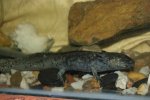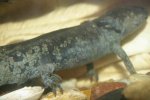Hey all - Disaster has struck the aquarium.
During November we lost 3 of the 4 adult axxies (inc. Ganesh ). Now only Cheech remains. Will and I had gone on vacation for over a month and, whilst we were away, Ganesh laid more eggs, which were not manged by the caretaker - they decomposed in the tank. Axies were covered in cream-ish coloured large blothes and could no longer stabilise their swimming or stop bobbing at the surface. They died in a large container we used when changing their water.
). Now only Cheech remains. Will and I had gone on vacation for over a month and, whilst we were away, Ganesh laid more eggs, which were not manged by the caretaker - they decomposed in the tank. Axies were covered in cream-ish coloured large blothes and could no longer stabilise their swimming or stop bobbing at the surface. They died in a large container we used when changing their water.
Cheech had seemingly made a full recovery, but was still a bit blotchy.The 2 week anti-fungal treatment seemed to work well. We cleaned out the aquarium and placed him in it without any of the rocks, plants etc. Over a month he recovered, but it was empty and that seeemed to stress him a bit. So Saturday arvo we cleaned off the rocks and replaced everything including the plants. He became visibly distressed within hours. Cheech returned to this desperate swimming style where he looks to be trying to escape out of the tank. By the next day he was blotchy and bobbing. We moved him to a container on Sunday (different to the death-container) and this morning (Monday) he was relaxing at the bottom.
 What do you think is making him sick in the aquarium?
What do you think is making him sick in the aquarium?
 What type of fungus/bacteria is attacking him and how does it operate?
What type of fungus/bacteria is attacking him and how does it operate?
 What can we do to toally erradicate this killer?
What can we do to toally erradicate this killer?
During November we lost 3 of the 4 adult axxies (inc. Ganesh
Cheech had seemingly made a full recovery, but was still a bit blotchy.The 2 week anti-fungal treatment seemed to work well. We cleaned out the aquarium and placed him in it without any of the rocks, plants etc. Over a month he recovered, but it was empty and that seeemed to stress him a bit. So Saturday arvo we cleaned off the rocks and replaced everything including the plants. He became visibly distressed within hours. Cheech returned to this desperate swimming style where he looks to be trying to escape out of the tank. By the next day he was blotchy and bobbing. We moved him to a container on Sunday (different to the death-container) and this morning (Monday) he was relaxing at the bottom.


